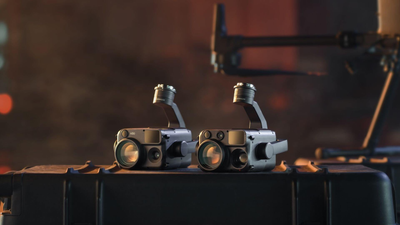How High Can Drones Fly?
- by Stefan Gandhi
If you’re standing in a windswept field in Yorkshire or overlooking the shimmering Thames at dusk, you might have glanced skywards and wondered: just how high can my drone climb? The answer in the UK is shaped by both the physical potential of the machine and the rules laid down by the Civil Aviation Authority (CAA).
Legal Altitude Limit In The UK
In the United Kingdom the legal ceiling for a drone or model aircraft flying in the Open Category is 120 metres (approximately 400 feet) above the closest point of the earth’s surface beneath it.
This means for the vast majority of recreational and commercial missions you should plan your flight path so your drone does not climb higher than this threshold. The limit exists to keep unmanned aircraft safely below altitudes where manned aircraft routinely operate, thereby reducing collision risk.
There are exceptions: if you’re conducting a survey or inspection of a tall structure (for instance a tower or mast over 105 metres) and have explicit permission, you may fly above 120 metres but subject to tight restrictions (such as staying within 15 metres above that structure and keeping within 50 metres horizontally).
Why The Limit Matters For You
Whether you’re flying for fun, photo content creation, or professional inspection work, this legal ceiling matters for several reasons:
-
Safety of airspace
By remaining below 120 metres you stay clear of most fixed-wing aircraft flight paths and minimise risk of collision with low-flying helicopters or emergency services.
-
Compliance and liability
If you exceed the limit without authorisation you expose yourself to enforcement action, fines or confiscation of equipment. The regulation is non-negotiable unless you hold a specific authorisation.
-
Operational planning
The height you fly impacts what you capture visually, how you avoid obstacles such as trees or terrain changes and how you manage aerial perspective. For professional work, knowing the legal ceiling helps determine if you need to apply for higher authorisation or choose a different flight profile.
What Determines The Practical Maximum Altitude
While 120 metres is the legal restriction, the actual maximum you can reach with your drone is affected by multiple factors:
-
Drone’s design and performance: Many consumer drones will struggle with high altitude flights because battery efficiency, air density and signal strength reduce as you climb. Pushing near the ceiling may mean reduced hover time or marginal control responsiveness.
-
Terrain variation: The “above ground level” measurement is defined relative to the closest point of the earth’s surface beneath the aircraft. If you launch on a ridge and fly over a valley you must be mindful that your drone might exceed 120 m above that valley floor even though your controller reads a lower figure.
-
Airspace restrictions and permissions: Even if your drone physically could go higher, you may be constrained by airspace type (controlled airspace around airports for example) or by the need to keep the drone within visual line of sight (VLOS). The CAA requires a drone to remain visible to the pilot without optical aids.
-
Weather and environmental conditions: Wind, temperature, humidity and altitude all affect performance. At altitude the air is thinner and the drone may have to work harder for lift; cold temperature may reduce battery efficiency; wind gusts may be more severe.
-
Signal strength and GPS connectivity: As you climb, line-of-sight to control and telemetry may degrade, especially if you’re flying behind obstacles or in a valley.
- Operational objectives: If you’re capturing cinematic shots you might want higher vantage points; if you’re surveying a rooftop you may need to hug closer to the structure and hence nearer the legal maximum.
Scenarios: Hobbyists Vs Professionals
Let’s compare how these altitude rules apply across typical user segments:
Creative hobbyists
You’ve purchased a compact drone, want to film dramatic coastline shots or capture sunset panoramas. For you the 120 m ceiling gives ample scope to shoot sweeping vistas. Focus on using that height wisely for composition, stable footage and framing your subjects. Since you’re flying for pleasure, ensure your flight remains within the legal limit, maintain visual line of sight and fly away from restricted zones.
Professionals (Survey, Inspection, Real-Estate)
As a professional user you may encounter structures or terrain why the standard 120 m may not suffice. In such cases you will need to assess if a specific category authorisation is required to fly above the limit. You’ll also need to integrate operational risk assessments, insurance, appropriate pilot competency and airspace clearance. Precision altitude control and data capture consistency become critical here.
Outdoor & Travel Enthusiasts
If you’re travelling with a drone to a mountainous region or to a remote UK coastline, terrain variation means you must interpret the 120 m rule based on local ground height. You might launch at a cliff top and fly over a valley so you must ensure you remain within the limit relative to the lowest point beneath your craft.
Tips For Maximising Pull From Your Drone Altitude
- Plan ahead: use mapping tools to identify ground elevation changes so you don’t unknowingly exceed height limits when flying over drop-off terrain.
- Monitor altitude read-out: many drones display “above take-off height” but height above ground level (AGL) may differ if terrain slopes.
- Pre-flight check airspace: run NOTAMs/airspace maps to ensure you’re not entering controlled zone or higher risk airspace.
- Use the height to your advantage: flying closer to the legal ceiling can give you superb vantage points for establishing shots, but make sure your subject matter still benefits by being in frame and resolution remains sufficient.
- Consider battery and weather: if you climb high, give yourself ample battery reserve for the return flight; ambient conditions may impact performance more at altitude.
- Log your flight: for professional work always record the altitude, mission profile and environment so you can demonstrate compliance and repeatability.
What If I Want To Fly Higher Than 120 Metres?
For certain operations one might need to fly above the standard 120 m limit. This is only permitted under the specific category of operations which requires an operational authorisation or waivers.
In practice that means you will need detailed risk assessment, airspace coordination, perhaps coordination with air traffic control and possibly a certified drone pilot. Most consumer drones and hobby flights will never require or qualify for this level of authorisation.
Summary Of Key Height Limits
- Standard maximum: 120 metres (400 feet) above the surface beneath the drone.
- Visual line of sight required: pilot must see drone without optical aids.
- When flying over varying terrain: height is calculated relative to the closest point of ground below.
- For special operations over tall structures: if authorised you may exceed 120 metres but only up to 15 metres above the structure and within 50 metres horizontally.
- Exceeding the limit without proper authorisation exposes you to enforcement.
FAQs
How high can I legally fly a drone in the UK?
You can legally fly up to 120 metres (400 feet) above the ground, measured from the closest point of earth’s surface beneath your drone.
If I’m on a hill, can I fly 120 metres above my take-off point?
No. The limit is relative to the ground beneath the drone at each point. If you’re on a ridge and fly out over a valley you must ensure the drone remains within 120 metres of the valley floor below it.
Can I fly higher than 120 metres if I’m doing commercial work?
Yes, but only with a specific authorisation under the specific category of operations. It involves risk assessment, potentially coordination with air-traffic control and satisfies higher regulatory standards.
What happens if I accidentally fly above 120 metres?
You could be in breach of the Drone Code and the regulations. This may result in fines, confiscation of the drone or legal proceedings depending on severity and risk.
Does the drone’s own altitude read-out always reflect height above ground?
Not necessarily. Many drones display altitude above launch height. Terrain drops or rises can mean the actual height above ground is different. Always check your relative altitude when flying over uneven terrain.
Are there different height limits if the drone weighs less than 250 g or is a toy model?
The height limit remains 120 metres in the open category regardless of weight. However smaller drones may have less restrictive horizontal and vertical spacing rules relative to people. But the altitude limit still applies unless you hold a specific authorisation.
Conclusion
Flying a drone opens up incredible vistas, creative opportunities and professional workflows. But altitude isn’t just about ‘how high can I go’, it is about how safely and legally you operate in airspace designed for both unmanned and manned aircraft. In the UK the 120 metre limit is your ceiling unless you have formal permission to go higher. For hobbyists the ceiling offers ample height to craft breathtaking shots.
For professionals it becomes a planning parameter to integrate into workflows, permissions and data capture strategy. Bear in mind your drone’s performance, terrain, weather and signal limitations as you plan your flights. By respecting these limits you ensure your aerial work is responsible and compliant.
Ready to update your kit and fly smarter? Visit the Coptrz official online store here for a wide selection of consumer and professional drones.




